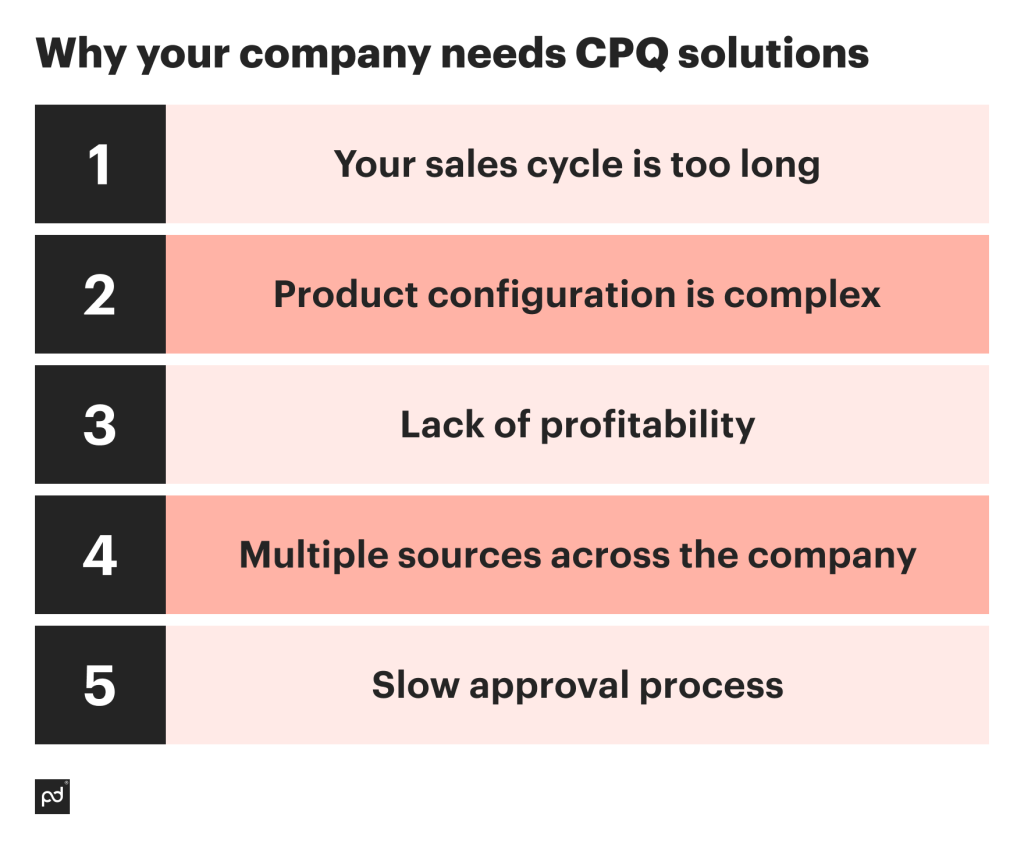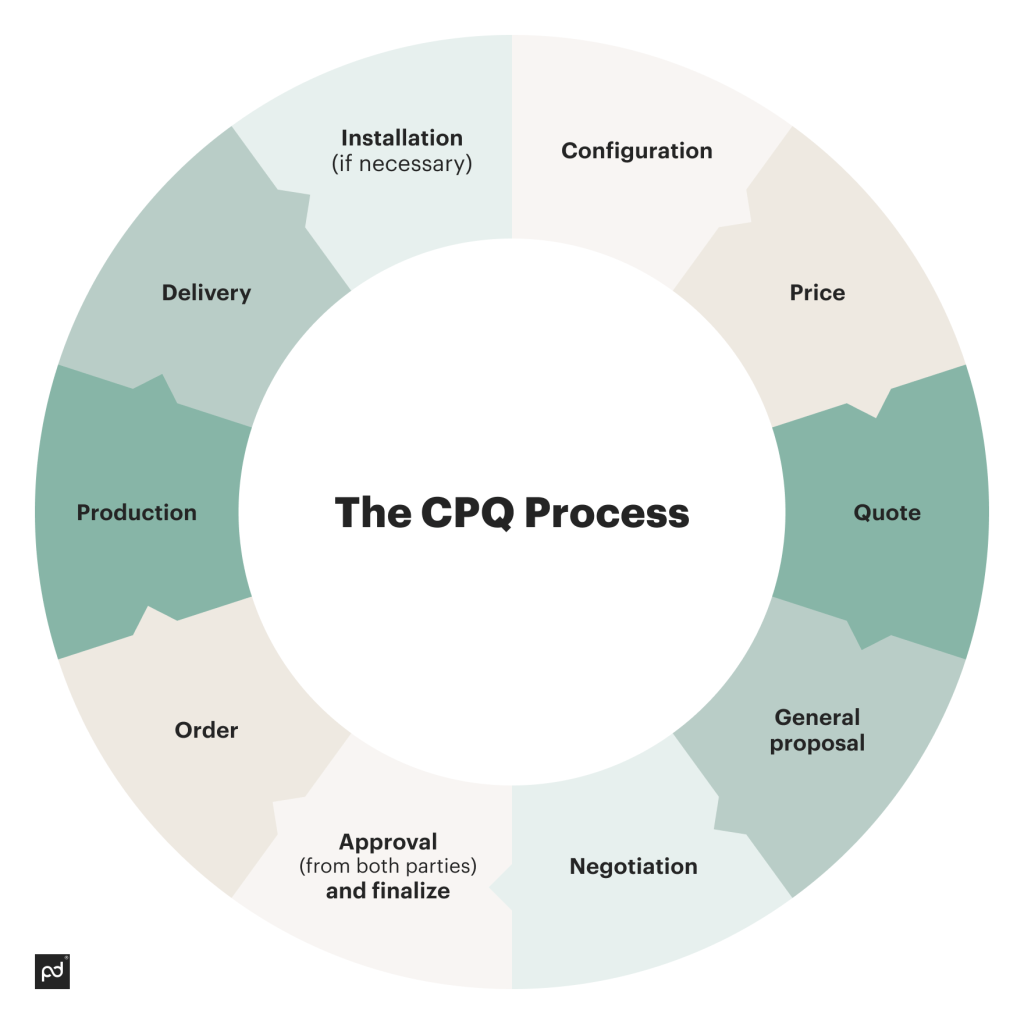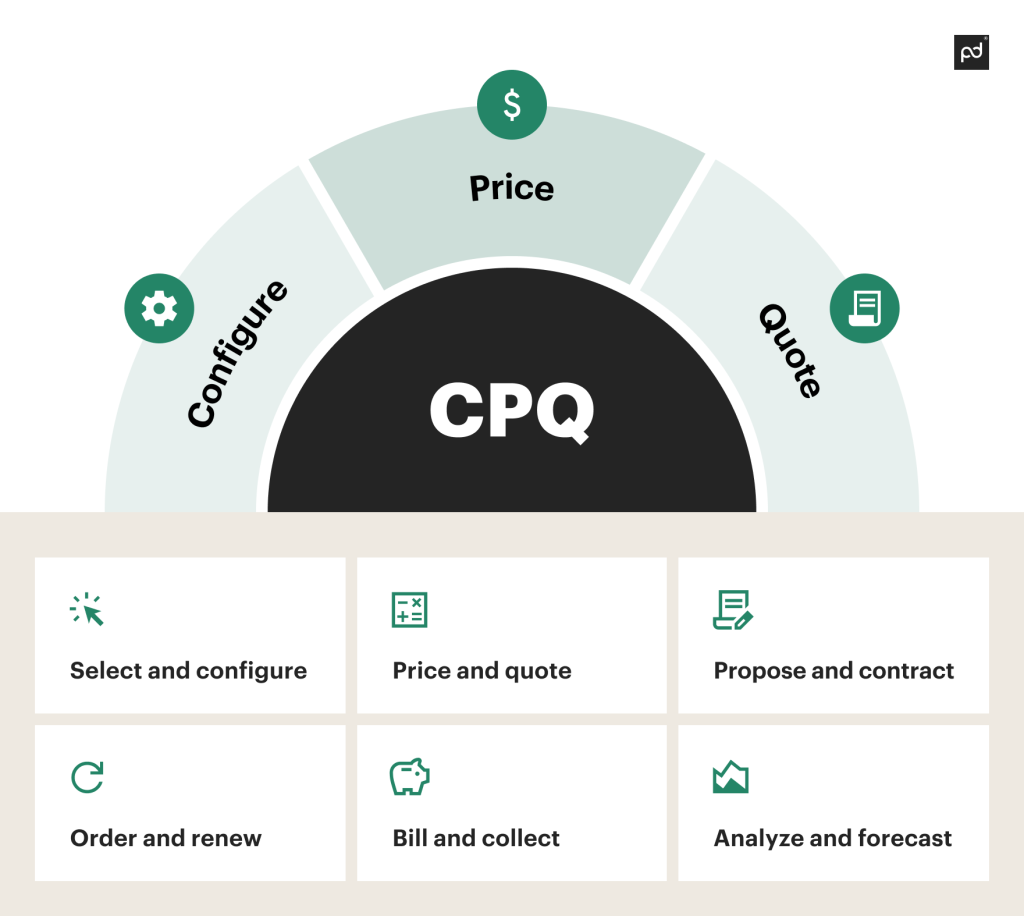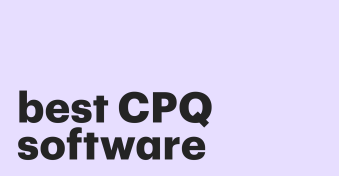Modern construction projects are more complex than ever before.
Between real-time pricing fluctuations, new building methods, and evolving industry regulations, quotes calculated by hand are sometimes outdated before they’re even ready to send!
Speed is critical for companies who want to stay competitive, but inaccurate estimates and human errors when creating your bill of quantities (BOQ) or calculating your cost of goods sold (COGS) can take thousands off the bottom line.
Configure, price, quoting (CPQ) tools can help teams exchange these manual processes for rules-based automation and turnkey proposal generation.
The result? Faster, more accurate quotes.
What is CPQ software, and why does it matter in construction?
CPQ — short for configure, price, quote — is a software solution designed to generate complex quotes with ease.
It’s a great option for sales teams working in construction and engineering fields, where changes in project design can necessitate alterations to materials and labor costs.
Business moves at a rapid pace. Without the speed and flexibility to adapt as projects evolve, sales teams can rapidly fall behind.
CPQ software enables teams to create smarter and more effective quotes at a rapid pace by breaking the process into three basic components:
- Configure bids by selecting and customizing the right combination of materials, services, and options for a given project.
- Price all project costs using rules-based pricing and rates that factor for discounts or taxes.
- Quote the entire project quickly via pre-built document templates.
Using this approach, CPQ tools are much faster than traditional solutions like spreadsheets or manual price books. Quotes are more accurate, pricing is precise, and outputs look great.
On top of that, CPQ platforms aren’t built to replace your existing takeoff software or CRM and ERP platforms. Instead, these tools can work together through integrated services to accelerate your entire pre-build and sales processes.
Where traditional methods fail

Firms relying on traditional or manual quoting workflows to generate construction quotes can fall behind due to inefficiencies in the bidding process.
Often, this happens because the communication chain between customers, subcontractors, and internal teams is long and the sales cycles are slow.
This is a problem that affects teams of every size, and it’s one reason that most contractors design their projects in-house.
With sales, if systems aren’t in place to account for complex product configurations — including dependencies and sub-components — the final bill of materials won’t offer accurate pricing.
While some of these issues can be handled by takeoff software that outputs a bill of quantities (BOQ), that documentation doesn’t always account for customer requirements and is limited by its functionality within the sales workflow.
Manually transforming a BOQ into a customer-facing quote forces sales reps to consult spreadsheets for correct pricing and consolidate that information into proposal documentation before any sales process can begin.
It’s a tedious, slow process that creates lengthy response times and cuts into overall profitability.
A CPQ system, especially one that integrates with your tech stack, can help sales teams spend less time calculating details and more time working to meet customer needs.
How CPQ software streamlines the pre-construction process

For many teams, a CPQ solution closes gaps between backend processes managed by ERP systems and front-end, customer-facing challenges.
While takeoff software like PlanSwift and Bluebeam can handle some of these obstacles, they aren’t designed to overcome the sales challenges that complicate the pre-construction phase.
Here’s what CPQ brings to your workspace.
A more complete process
In some ways, a CPQ tool is like a resource planning software for the front end of the business.
Rather than focusing on managing resources like materials or schedules, CPQ is focused on building customer-ready quotes that bridge the gap between internal planning and customer-facing communication.
To do this, CPQ relies on a centralized product catalog for pricing around materials, labor, and related services. Much of this can be automated, and the output can be added to a pre-built quote or proposal template.
Plus, while CPQ tools can stand alone, they can also integrate with other parts of your tech stack if you’re using CRM platforms (Salesforce, HubSpot, etc.) or payment tools like Stripe or Quickbooks.
CPQ tools tie together your entire pre-build process, from initial estimates generated in your takeoff tool to the final quote or proposal meant for customers.
More accurate quotes
Estimates have to be accurate. Small mistakes cost money, while large oversights can cause project delays and ruin the customer experience.
CPQ can eliminate these errors — especially if teams are using manual quoting processes.
With CPQ, teams can rely on rules-based pricing systems to eliminate guesswork and inconsistencies.
For example, CPQ rules could be used to calculate a base price for standard home design, with additional costs added to factor for total square footage, materials upgrades, distributor fees, or geographic factors.
These tools can help reps offer more precise estimates and quotes, reducing the likelihood of a costly change order somewhere down the line.
Faster revisions
Even with more accurate quoting, projects evolve as client requests change. If these changes aren’t addressed quickly and accurately, they can cause issues later in the project. According to one report, 25% of major projects have large schedule deviations, while roughly 13% have total cost deviations greater than one-fourth of the project total.
CPQ software eases this process by helping teams quickly modify configurations, update pricing, and regenerate proposals.
Because pricing is configured around a centralized product catalog, teams can simply select the additional materials and adjust labor costs in order to revise the quote.
When product libraries are set up using rules and conditions, the process is even faster.
Using a simplified example, assume that a change order requires additional flooring.
If all of the materials required to lay that flooring are bundled together, adding them to the quote can be done in one or two clicks.
This agility can help to keep projects moving forward and eliminate unnecessary delays.
Faster turnaround times
Long turnaround times on quotes can be the difference between winning and losing a bid.
This can also help to ensure that materials are ordered well before construction begins — something that over 60% of teams feel is necessary to combat supply chain issues.
With CPQ software, it’s possible to accelerate the quoting process through automation, bundling, and modularization.
By including pricing details as part of your materials catalog or bundling items that need to be sold as a unit, teams can eliminate manual inputs and pricing models that make sense for their business.
The ability to offer rough estimates in a few hours and highly accurate quotes as projects gain more definition can give companies a competitive edge.
Plus, faster quoting processes allow teams to bid on more work and pursue additional opportunities.
Client-ready proposals
Most construction software falls short when it’s time to actually close deals. Takeoff tools are great for creating a realistic BOQ, but they don’t account for the full cost of business operations.
By design, CPQ tools can provide quotes that offer detailed cost breakdowns, bundling options for materials and services (great for upselling or cross-selling), and interactive elements like e-signing to allow for client sign off.
Platforms like PandaDoc CPQ also allow teams to generate polished, branded quotes that look great and help your business stand apart from competitors.
Choosing the right CPQ solution for your construction business

There are a ton of CPQ platforms out there, and the software you choose will have a big impact on your sales architecture.
Here are a few important features you should consider when selecting your CPQ platform:
Integrations
Software solutions that integrate with components of your existing tech stack can reduce friction between platforms.
Most CPQ tools will integrate with traditional CRMs and/or ERPs, but they may not interact with specialized construction software. This means that teams will need to have a process in place to migrate data from one platform to another.
For example, teams looking to use a CPQ tool may need to import or manually rebuild a materials list generated by takeoff software in order to create an itemized quote.
Workflow and integration opportunities will depend on the business systems you use and how well they interact with one another.
Rules-based pricing
A key component of any CPQ platform, rules-based pricing capabilities allow the software to account for changes in material costs, labor rates, and more.
PandaDoc CPQ uses customizable, rules-based pricing so that total costs fluctuate based on the conditions you set without losing control over the pricing process.
In addition to adjusting for cost, teams can also use these tools to account for regional taxes, service fees, discounts, and other surcharges that factor into total project costs.
Proposal templates
Many CPQ solutions offer pre-set proposal outputs built by an in-house software engine.
These solutions are fast and easy, but they provide limited flexibility in the look and feel of the final product.
While proposal designers can usually adjust logos, images, and make minor layout changes, the final output is roughly the same.
To get more control, you’ll need a CPQ solution that allows for dynamic template creation. In this scenario, teams can design a customer-facing proposal that matches the exact look and feel of the brand.
Once these templates are built, they can be locked and offered to sales reps during quote generation.
This prevents reps from changing key elements of the document and accelerates the sales cycle by adding reusable documentation for the quoting process.
When a quote needs to be built, the rep selects the template and adds pricing details via the built-in product library.
Product details are automatically inserted into the template, without changing the layout.
After that, documents can be queued for an approval process or sent directly to the customer for review.
Scalability
Some CPQ solutions are built under the assumption that customers will offer vast, complex product selections.
If you’re a smaller or niche organization, make sure you select CPQ software that is flexible enough to meet your needs without becoming too overbearing.
Construction companies managing in-home renovations may not need the scalability of a CPQ solution that would meet the needs of a commercial construction company.
At the same time, make sure that your CPQ tool can scale with you as your business grows.
The software should be able to adapt to your needs, whether you’re bidding on one project at a time or multiple projects at once.
User-friendly interfaces
Ease of use is critical for swift adoption.
CPQ platforms with unintuitive interfaces can cause friction in your workspace, especially as teams struggle to understand the software.
If possible, find a CPQ solution that’s easy for your team to use and offers an user-friendly, interactive approach. This can help you get up and running quickly, reducing training time and maximizing ROI.
Ready to improve your quotes? Try PandaDoc CPQ
No matter the size, construction projects aren’t simple. They’re complicated, complex, and competitive.
Without the right tools, the administrative load required to build and offer competitive quotes to customers can quickly overwhelm an entire team.
If that sounds familiar, PandaDoc CPQ might be a strong fit. Our CPQ solution offers robust integrations, rules-based pricing, customizable document templates, and much more.
Simplify your entire pre-construction phase, and get proposals out the door faster than ever.
Schedule a demo today and learn firsthand how PandaDoc can elevate your entire business workflow.
Disclaimer
PandaDoc is not a law firm, or a substitute for an attorney or law firm. This page is not intended to and does not provide legal advice. Should you have legal questions on the validity of e-signatures or digital signatures and the enforceability thereof, please consult with an attorney or law firm. Use of PandaDoc services are governed by our Terms of Use and Privacy Policy.
Frequently asked questions
-
Takeoff software is great for quantifying materials and labor from blueprints. Some of the newer tools can even interpret CAD files using AI or will allow you to build a layout inside the platform.
While they’re great for ensuring that a project will be profitable, takeoff tools stop short of turning those estimates into polished, client-ready quotes.
On the other hand, CPQ can integrate into your entire pre-build process.
When used at the early stages, sales reps can use guided selling tools and configurable products to provide high-level estimates.
Later on, these tools help teams transform BOQ and materials lists into highly accurate, customer-facing documentation that looks great and is easy to build.
-
No, and it probably won’t.
Most major takeoff solutions don’t communicate with CPQ tools, so teams should expect to rebuild the materials list through a manual process.
This labor can be offset by using product configurations and bundling options inside your CPQ platform. Using this strategy, component products are added automatically, reducing the need for reps to build quotes in a line-by-line fashion.
-
Your CRM can track client interactions and project details, which is useful for keeping track of communications, change requests, and project progress.
When integrated with platforms like PandaDoc CPQ, CRMs can exchange essential client information. This eliminates the need to enter customer information manually and allows reps to personalize templates in just a few clicks.
-
Not at all. CPQ software can benefit businesses of all sizes.
For smaller firms, using CPQ can streamline business operations and help teams compete for larger projects. Larger firms can use the scalability to handle multi-phase projects and accommodate larger sales teams.


